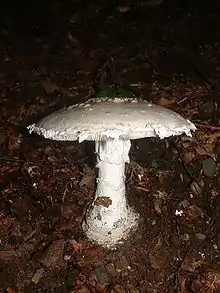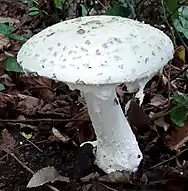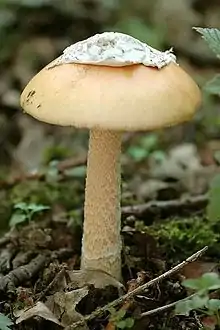Amanita strobiliformis
Amanita strobiliformis is a species of mushroom. It is commonly referred to as warted amanita.
| Amanita strobiliformis | |
|---|---|
 | |
| Scientific classification | |
| Kingdom: | Fungi |
| Division: | Basidiomycota |
| Class: | Agaricomycetes |
| Order: | Agaricales |
| Family: | Amanitaceae |
| Genus: | Amanita |
| Species: | A. strobiliformis |
| Binomial name | |
| Amanita strobiliformis (Paulet ex Vittad.) Bertill. | |
Description
The cap is 3 to 10 inches across, is rough with warts which sometimes fall away leaving the cap smooth, whitish, and sometimes has some brown. The gills are free and rounded behind. The veil is large and sometimes adhere to the margin of the cap. The stipe (stem) is 3 to 8 inches long, thick, white, bulbous, and sometimes weighs a pound. The spores are elliptical.[1]
Edibility
The genus Amanita contains some of the most toxic fungi known. Some amanitas are deadly in only very small doses, while others are relatively harmless and sometimes even considered fit for human consumption. There are different views on A. strobiliformis edibility. Some sources advice against consuming them, other sources considers them edible.
Toxicity
Amanita strobiliformis contains ibotenic acid and muscimol, much like Amanita muscaria and Amanita pantherina.[2][3] In combination with muscimol, ibotenic acid is a neurotoxin that can cause hallucinations, gastrointestinal distress, and at high doses, convulsions, psychosis and death. In many sources the mushroom is said to be harmless, but still then its edibility is doubted and uncertain,[1][4][5][6] so caution should be taken before consuming this fungus. As with many other fungi, similarly to plants, toxin levels may vary depending on the growing conditions, which in turn may explain the differences in evaluating edibility.
Habitat
Amanita strobiliformis is associated mycorhizal with deciduous trees, preferring scattered forest, or woodland borders, usually on alkaline soil.[7][8] It grows singular fruits and sometimes clusters.[5] The fungus is rare.[9]
In Europe, it grows from the Mediterranean region to the Netherlands and England, and maybe further north.[7]
Gallery

References
- MclLVAINE, Charles; K. Macadam, Robert (1973). One Thousand American Fungi. Dover Publications, Inc. p. 19.
- Michael Edward Peterson, Patricia A. Talcott (2006). "61" (PDF). Small animal toxicology. Missouri, United States: Elsevier Saunders. p. 869. ISBN 978-0-7216-0639-2.
- Ammirati Joseph F., Traquair James A.; Paul A. Horgen (1985). "11 (Ibonetic acid-muscimol)" (PDF). Poisonous mushrooms of the northern United States and Canada. United States: University of Minnesota Press. p. 168. ISBN 0-8166-1407-5.
In Japan, Amanita strobiliformis (Paulet ex Vittad.) Bertillon is reported to contain ibotenic acid (Benedict 1972)
- New York Botanical Garden, Mycological Society of America (1910). Mycologia, Volume 2. New York Botanical Garden. p. 261.
- Taylor, Thomas (1897). Student's hand-book of mushrooms of America edible and poisonous, Issues 1-5. A. R. Taylor. p. 8.
- Chambers Coker, William (1917). The Amanitas of the Eastern United States. Elisha Mitchell Society. p. 74.
- Amanita strobiliformis (Paulet ex Vittad.) Bertill. - Warted Amanita
- Amanita strobiliformis
- Joseph Berkeley, Miles (1860). Outlines of British fungology: containing characters of above a thousand species of Fungi, and a complete list of all that have been described as natives of the British Isles. L. Reeve. pp. 90.
Amanita strobiliformis.
External links
| Wikimedia Commons has media related to Amanita strobiliformis. |
